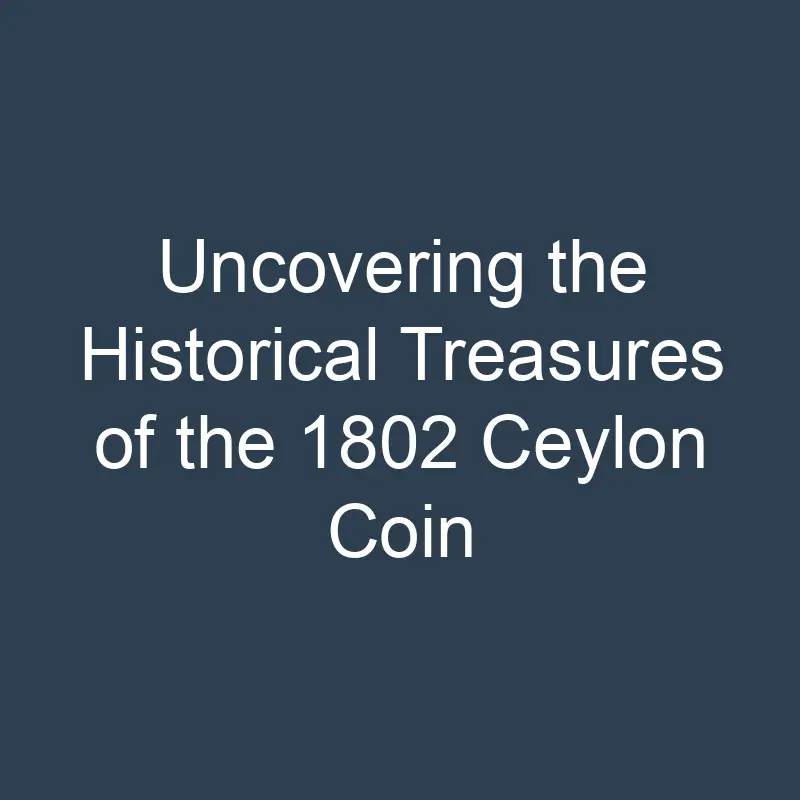
Welcome to our exploration of the fascinating world of numismatics! Today, we delve into the intriguing story behind the 1802 coin from Ceylon. This coin, with its rich history and unique design, offers us a glimpse into the cultural and economic landscape of a bygone era.
As we unravel the mysteries surrounding the 1802 coin from Ceylon, we uncover tales of trade, colonization, and artistic craftsmanship. Each detail on this coin serves as a testament to the intricate connections between nations and the evolution of currency.
Join us on this journey as we uncover the significance of the 1802 coin from Ceylon and how it continues to captivate collectors and historians alike. Let’s embark on a voyage through time, exploring the stories etched in metal and the legacy they leave behind.
History of Ceylon
Ceylon, known today as Sri Lanka, has a vibrant history that dates back thousands of years. Here, we delve into the rich tapestry of this island nation:
- Ancient Roots: Ceylon’s history boasts ancient civilizations like Anuradhapura, Polonnaruwa, and Sigiriya, known for their advanced urban planning and architecture.
- Colonial Past: The island’s strategic location in the Indian Ocean attracted European powers, leading to periods of Portuguese, Dutch, and British colonization. This colonial heritage left a lasting imprint on Ceylon’s culture and society.
- Independence Struggle: Ceylon gained independence in 1948, marking a significant milestone in its history. The country transitioned from a British colony to a self-governing nation, shaping its identity and future trajectory.
- Cultural Diversity: The fusion of various ethnicities, religions, and languages has enriched Ceylon’s cultural landscape. This diversity is reflected in its art, music, dance, and culinary traditions, making it a melting pot of heritage and creativity.
- Modern Developments: In recent decades, Ceylon, now Sri Lanka, has made strides in economic growth, infrastructure development, and international relations. The country continues to evolve while preserving its storied past.
Through these glimpses into Ceylon’s history, we gain a deeper appreciation for the 1802 coin and its connection to the enduring legacy of this remarkable island nation.
Introduction of Coinage
When delving into the rich history of Ceylon, one cannot overlook the introduction of coinage to the island. The 1802 coin from Ceylon holds a significant place in this narrative, symbolizing a crucial era of economic and cultural evolution.
During ancient times, bartering was a common practice for trade in Ceylon. However, as civilizations advanced, the necessity for a standardized medium of exchange became apparent. This need paved the way for the minting of coins, marking a pivotal moment in the island’s economic history.
The first coins in Ceylon were believed to have been introduced by ancient rulers, emphasizing their authority and power. Over time, these coins evolved in design and material, reflecting the changing dynasties and influences that shaped Ceylon’s identity.
Design and Symbolism
When examining the 1802 coin from Ceylon, one can’t help but be captivated by its intricate design and rich symbolism. The obverse side typically features a depiction of a prominent ruler of the time, showcasing their authority and power. These designs often showcase the ruler’s profile or emblem, surrounded by inscriptions in ancient scripts.
On the reverse side, symbolism plays a crucial role in portraying elements significant to Ceylon’s culture and history. Iconic symbols such as religious motifs, local flora and fauna, or symbolic representations of prosperity and abundance are commonly found on these coins. Each element carefully chosen to convey a specific message or pay homage to the beliefs and traditions of the era.
Moreover, the materials used in crafting these coins also hold symbolic meaning. Precious metals like gold and silver not only added to the intrinsic value of the coin but also symbolized wealth, power, and stability. The meticulous craftsmanship involved in minting these coins further highlights the importance placed on this standardized medium of exchange.
Overall, the design and symbolism of the 1802 coin from Ceylon provide a window into the cultural, historical, and artistic values of the time, making them not just pieces of currency but also artifacts of significance in the island’s heritage.
Circulation and Trade
When examining the 1802 coin from Ceylon, we gain valuable insights into its circulation and trade impact. These coins served as a crucial medium of exchange that facilitated transactions and trade activities within and beyond Ceylon’s borders.
- Diverse Economies: The circulation of these coins in local and international trade routes underscored Ceylon’s economic integration with the global economy of the time.
- Symbol of Stability: The widespread use of the 1802 coin signified economic stability and the recognition of Ceylon as a key player in the regional trade dynamics.
- Trade Networks: These coins played a pivotal role in supporting trade networks, enabling merchants and traders to conduct business efficiently and reliably.
- Cross-Cultural Exchange: Through trade, these coins also facilitated cross-cultural exchanges, reflecting the interconnected nature of trade during that era.
- Historical Significance: The circulation of the 1802 coin from Ceylon not only fueled economic activities but also left an indelible mark on the region’s historical landscape.
As we delve deeper into the circulation and trade aspects of the 1802 coin from Ceylon, we uncover a tapestry of economic significance and trade relations that shaped the region’s history and heritage.
Legacy and Collectibility
When it comes to the 1802 coin from Ceylon, its legacy extends far beyond its economic impact. These coins serve as valuable historical artifacts that provide insights into the economic and cultural landscape of that time. Here are some key points highlighting the legacy and collectibility of the 1802 coin from Ceylon:
- Historical Significance: The 1802 coin is a tangible link to Ceylon’s rich history, offering a glimpse into the economic activities, trade relations, and cultural exchanges of the era.
- Numismatic Value: Collectors prize the 1802 coin for its rarity and historical significance, making it a sought-after item in numismatic circles.
- Artistic Appeal: Beyond its monetary value, the 1802 coin from Ceylon often features unique designs and craftsmanship that appeal to collectors and enthusiasts alike.
- Educational Value: Studying these coins provides valuable insights into the economic policies, historical events, and trade practices of 19th-century Ceylon.
- Global Appeal: The collectibility of the 1802 coin extends beyond Ceylon, attracting interest from collectors worldwide due to its unique history and limited availability.
- Preservation Efforts: Various organizations and collectors actively work towards preserving and showcasing these coins to ensure their legacy endures for future generations.
In essence, the 1802 coin from Ceylon continues to captivate collectors, historians, and enthusiasts alike, embodying a unique blend of historical significance, artistic value, and cultural relevance.
Key Takeaways
- The 1802 coin from Ceylon offers a glimpse into the cultural and economic landscape of a bygone era.
- Ceylon’s history is rich and diverse, shaped by ancient civilizations, colonial influences, and modern developments.
- The introduction of coinage in Ceylon marked a pivotal moment in the island’s economic history, symbolizing authority and power.
- The design and symbolism of the 1802 coin reflect cultural, historical, and artistic values of the time.
- These coins facilitated trade activities, symbolizing economic stability and playing a role in cross-cultural exchanges.
- The legacy of the 1802 coin extends beyond its economic impact, being prized for its historical significance, artistic appeal, and educational value.
Conclusion
The 1802 coin from Ceylon stands as a captivating piece of history, cherished by collectors worldwide for its rarity and intricate craftsmanship. Its significance extends beyond its monetary value, offering a glimpse into the economic landscape and trade practices of 19th-century Ceylon. This coin serves as a tangible link to a bygone era, sparking curiosity and admiration among historians, numismatists, and enthusiasts alike. Its enduring allure lies in the fusion of historical importance, artistic excellence, and cultural richness, making it a prized possession in the realm of numismatics. As we continue to uncover the stories embedded in these coins, we deepen our understanding of Ceylon’s past and the global connections that shaped its history. The legacy of the 1802 coin from Ceylon lives on, inspiring a sense of wonder and appreciation for the treasures of the past.
Frequently Asked Questions
What is the significance of the 1802 coin from Ceylon?
The 1802 coin from Ceylon holds historical importance as a relic of the region’s past, reflecting economic activities and cultural exchanges.
Why do collectors value the 1802 coin from Ceylon?
Collectors cherish this coin for its rarity, unique designs, and skilled craftsmanship, making it a sought-after item in numismatic circles.
What insights can studying the 1802 coin from Ceylon provide?
Studying these coins sheds light on 19th-century Ceylon’s economic policies, trade practices, and historical context, offering valuable knowledge to researchers.
Why is there global interest in the 1802 coin from Ceylon?
The coin’s historical significance and artistic appeal captivate a worldwide audience, driving interest and sparking preservation efforts.
Who is fascinated by the 1802 coin from Ceylon?
Collectors, historians, and enthusiasts are drawn to this coin, appreciating its blend of historical depth, artistic value, and cross-cultural significance.






